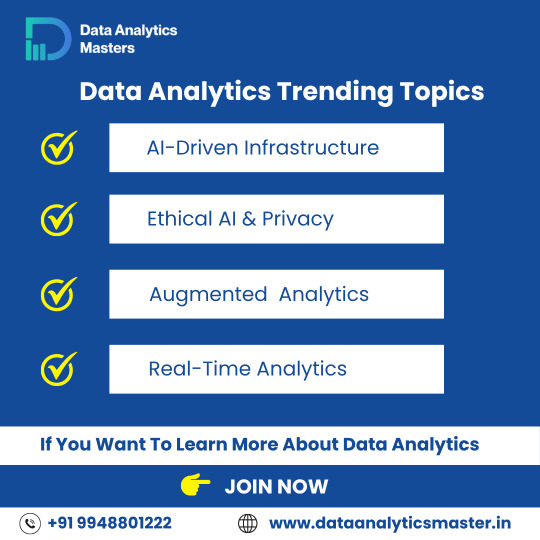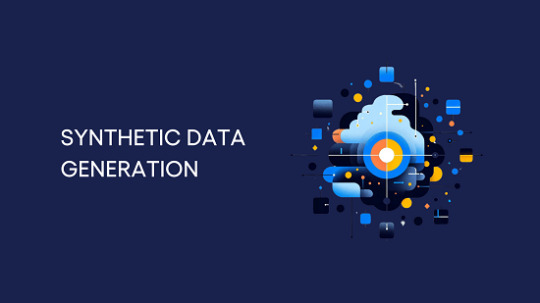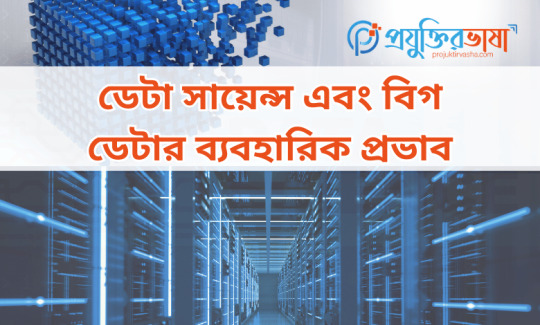#FutureOfData
Explore tagged Tumblr posts
Text

📈 Data Analytics Trending
✅ AI-Driven Infrastructure – Smarter systems, faster decisions
✅ Ethical AI & Privacy – Responsible innovation matters
✅ Augmented Analytics – AI + Human insight = Better decisions
✅ Real-Time Analytics – Act as things happen!
✨ Stay updated, stay ahead!
📊 Master these trending topics with Data Analytics Masters.
✅ Why Choose Us?
✔️ 100% practical training
✔️ Real-time projects & case studies
✔️ Expert mentors with industry experience
✔️ Certification & job assistance
✔️ Easy-to-understand Telugu + English mix classes
📍 Institute Address:
3rd Floor, Dr. Atmaram Estates, Metro Pillar No. A690,
Beside Siri Pearls & Jewellery, near JNTU Metro Station,
Hyder Nagar, Vasantha Nagar, Hyderabad, Telangana – 500072
📞 Contact: +91 9948801222 📧 Email: [email protected] 🌐 Website: https://dataanalyticsmasters.in
#DataAnalytics#TrendingTech#AIinAnalytics#RealTimeAnalytics#EthicalAI#AugmentedAnalytics#DataScience#MachineLearning#ArtificialIntelligence#BigData#DataDriven#FutureOfData#AnalyticsTrends#TechUpdates#LearnDataAnalytics#DataAnalyticsMasters#AITrends2025#DataPrivacy#AnalyticsForBusiness#TechEducation
0 notes
Text
Beyond the Pipeline: Choosing the Right Data Engineering Service Providers for Long-Term Scalability
Introduction: Why Choosing the Right Data Engineering Service Provider is More Critical Than Ever
In an age where data is more valuable than oil, simply having pipelines isn’t enough. You need refineries, infrastructure, governance, and agility. Choosing the right data engineering service providers can make or break your enterprise’s ability to extract meaningful insights from data at scale. In fact, Gartner predicts that by 2025, 80% of data initiatives will fail due to poor data engineering practices or provider mismatches.
If you're already familiar with the basics of data engineering, this article dives deeper into why selecting the right partner isn't just a technical decision—it’s a strategic one. With rising data volumes, regulatory changes like GDPR and CCPA, and cloud-native transformations, companies can no longer afford to treat data engineering service providers as simple vendors. They are strategic enablers of business agility and innovation.
In this post, we’ll explore how to identify the most capable data engineering service providers, what advanced value propositions you should expect from them, and how to build a long-term partnership that adapts with your business.
Section 1: The Evolving Role of Data Engineering Service Providers in 2025 and Beyond
What you needed from a provider in 2020 is outdated today. The landscape has changed:
📌 Real-time data pipelines are replacing batch processes
📌 Cloud-native architectures like Snowflake, Databricks, and Redshift are dominating
📌 Machine learning and AI integration are table stakes
📌 Regulatory compliance and data governance have become core priorities
Modern data engineering service providers are not just builders—they are data architects, compliance consultants, and even AI strategists. You should look for:
📌 End-to-end capabilities: From ingestion to analytics
📌 Expertise in multi-cloud and hybrid data ecosystems
📌 Proficiency with data mesh, lakehouse, and decentralized architectures
📌 Support for DataOps, MLOps, and automation pipelines
Real-world example: A Fortune 500 retailer moved from Hadoop-based systems to a cloud-native lakehouse model with the help of a modern provider, reducing their ETL costs by 40% and speeding up analytics delivery by 60%.
Section 2: What to Look for When Vetting Data Engineering Service Providers
Before you even begin consultations, define your objectives. Are you aiming for cost efficiency, performance, real-time analytics, compliance, or all of the above?
Here’s a checklist when evaluating providers:
📌 Do they offer strategic consulting or just hands-on coding?
📌 Can they support data scaling as your organization grows?
📌 Do they have domain expertise (e.g., healthcare, finance, retail)?
📌 How do they approach data governance and privacy?
📌 What automation tools and accelerators do they provide?
📌 Can they deliver under tight deadlines without compromising quality?
Quote to consider: "We don't just need engineers. We need architects who think two years ahead." – Head of Data, FinTech company
Avoid the mistake of over-indexing on cost or credentials alone. A cheaper provider might lack scalability planning, leading to massive rework costs later.
Section 3: Red Flags That Signal Poor Fit with Data Engineering Service Providers
Not all providers are created equal. Some red flags include:
📌 One-size-fits-all data pipeline solutions
📌 Poor documentation and handover practices
📌 Lack of DevOps/DataOps maturity
📌 No visibility into data lineage or quality monitoring
📌 Heavy reliance on legacy tools
A real scenario: A manufacturing firm spent over $500k on a provider that delivered rigid ETL scripts. When the data source changed, the whole system collapsed.
Avoid this by asking your provider to walk you through previous projects, particularly how they handled pivots, scaling, and changing data regulations.
Section 4: Building a Long-Term Partnership with Data Engineering Service Providers
Think beyond the first project. Great data engineering service providers work iteratively and evolve with your business.
Steps to build strong relationships:
📌 Start with a proof-of-concept that solves a real pain point
📌 Use agile methodologies for faster, collaborative execution
📌 Schedule quarterly strategic reviews—not just performance updates
📌 Establish shared KPIs tied to business outcomes, not just delivery milestones
📌 Encourage co-innovation and sandbox testing for new data products
Real-world story: A healthcare analytics company co-developed an internal patient insights platform with their provider, eventually spinning it into a commercial SaaS product.
Section 5: Trends and Technologies the Best Data Engineering Service Providers Are Already Embracing
Stay ahead by partnering with forward-looking providers who are ahead of the curve:
📌 Data contracts and schema enforcement in streaming pipelines
📌 Use of low-code/no-code orchestration (e.g., Apache Airflow, Prefect)
📌 Serverless data engineering with tools like AWS Glue, Azure Data Factory
📌 Graph analytics and complex entity resolution
📌 Synthetic data generation for model training under privacy laws
Case in point: A financial institution cut model training costs by 30% by using synthetic data generated by its engineering provider, enabling robust yet compliant ML workflows.
Conclusion: Making the Right Choice for Long-Term Data Success
The right data engineering service providers are not just technical executioners—they’re transformation partners. They enable scalable analytics, data democratization, and even new business models.
To recap:
📌 Define goals and pain points clearly
📌 Vet for strategy, scalability, and domain expertise
📌 Watch out for rigidity, legacy tools, and shallow implementations
📌 Build agile, iterative relationships
📌 Choose providers embracing the future
Your next provider shouldn’t just deliver pipelines—they should future-proof your data ecosystem. Take a step back, ask the right questions, and choose wisely. The next few quarters of your business could depend on it.
#DataEngineering#DataEngineeringServices#DataStrategy#BigDataSolutions#ModernDataStack#CloudDataEngineering#DataPipeline#MLOps#DataOps#DataGovernance#DigitalTransformation#TechConsulting#EnterpriseData#AIandAnalytics#InnovationStrategy#FutureOfData#SmartDataDecisions#ScaleWithData#AnalyticsLeadership#DataDrivenInnovation
0 notes
Text
The Role of Data Science in Healthcare and Diagnosis
Data science is changing many areas, and healthcare is one of the most important ones. Today, healthcare uses data science to help doctors find diseases early, make better decisions, and create treatments that fit each patient. Hospitals, clinics, and researchers have a lot of health data, like patient records, test results, and information from devices like fitness trackers. Data science helps to understand all this data and use it to improve health and save lives.
Why Healthcare Needs Data Science
Healthcare creates huge amounts of data every day. Each patient has a medical history, lab tests, prescriptions, and other information. But this data is often spread out and not easy to use. Data science helps by analyzing this data and finding useful patterns.
Using tools like machine learning and statistics, data scientists find important information that can help doctors and nurses make faster and better decisions. This means patients get the right care at the right time.
How Data Science Helps Healthcare
1. Finding Diseases Early
One of the biggest ways data science helps is by spotting diseases early. Doctors use data science models trained on thousands of medical images and patient data to find signs of diseases like cancer or heart problems before they become serious.
For example, some AI tools can look at breast cancer scans and find tiny changes that a doctor might miss. This helps catch cancer early when treatment is easier and more effective.
2. Predicting Health Problems
Data science can also predict which patients might get sick or need extra care. Hospitals use this to plan treatment and avoid emergencies.
For example, data models can predict if a patient might develop a serious infection like sepsis. If the model alerts the doctors early, they can start treatment sooner and save the patient’s life.
3. Making Treatment Personal
Every person is different, so one treatment might not work for everyone. Data science helps by studying a patient’s genes, lifestyle, and past treatments to suggest the best medicine or therapy for them.
In cancer treatment, for example, doctors use genetic data to choose the drugs that will work best for a patient’s specific type of cancer. This approach is called “precision medicine.”
4. Helping Doctors Read Medical Images
Reading X-rays, MRIs, or CT scans takes time and skill. Data science uses AI to help doctors by quickly analyzing these images and pointing out problems.
For example, AI can find small lung nodules on a chest X-ray, which could be early signs of lung cancer. This helps doctors make faster and more accurate diagnoses.
5. Finding New Medicines
Creating new drugs takes a long time and costs a lot of money. Data science can speed up this process by predicting which chemicals might work as medicines.
During the COVID-19 pandemic, data science helped researchers understand the virus and find possible treatments faster than ever before.
Tools Used in Healthcare Data Science
Healthcare data science uses many computer tools to do its work:
Python and R: These programming languages help analyze data and build models.
TensorFlow and PyTorch: These tools help create AI programs that learn from data.
Tableau and Power BI: These help make charts and graphs to show data clearly.
Cloud platforms like AWS and Azure: These provide places to store and process big amounts of data quickly.
Together, these tools help doctors and data scientists work as a team to improve health care.
Challenges of Using Data Science in Healthcare
Even though data science is very helpful, there are some challenges:
Privacy: Patient data is very private. It must be kept safe and only used in the right ways.
Data Quality: Sometimes data is incomplete or wrong, which can lead to mistakes.
Understanding AI: Doctors need to know how AI makes decisions to trust it, but sometimes AI is hard to understand.
Fairness: If data is biased, AI might make unfair decisions that hurt some patients.
Healthcare providers, data scientists, and regulators must work together to solve these problems carefully.
What the Future Looks Like
The future of healthcare will rely even more on data science. Some examples include:
AI assistants helping with mental health support.
Wearable devices that monitor health and alert doctors in emergencies.
Hospitals using data to manage patient care and resources better.
Digital models of patients that test treatments before trying them in real life.
As technology improves and more data becomes available, healthcare will become faster, safer, and more personal.
Conclusion
Data science is changing healthcare in many good ways. It helps find diseases early, predicts health risks, personalizes treatments, helps doctors read medical images, and speeds up drug discovery. These improvements come from using data and technology together.

#data#datascience#datastorytelling#machinelearning#bigdata#analytics#technology#informationtechnology#ai#datainsights#dataanalysis#datavisualization#predictiveanalytics#dataengineer#businessintelligence#deeplearning#dataanalytics#storytellingwithdata#pythonfordatascience#datajourney#mlmodels#cleandata#datascientistlife#datamakesdifference#dataisthenewoil#datasciencetools#techblog#futureofdata#insightsfromdata#datadriven
0 notes
Text
Machine Learning in Predictive Analytics: Turning Data into Business Gold
Every smart decision begins with the right prediction—and that’s where machine learning in predictive analytics shines.
This blog is your guide to: 🔍 How ML models unlock future trends 📈 Real-world use cases that drive business outcomes 🧠 The synergy between ML algorithms and predictive accuracy 🚀 Why it matters for decision-makers across industries
If you’re a tech strategist, product head, or founder aiming to turn data into decisions, this blog is your power move.
#MachineLearning#PredictiveAnalytics#DataScience#MLinBusiness#AIApplications#SmartDecisionMaking#BusinessAnalytics#TechLeadership#DigitalTransformation#ScalableSolutions#KodyTechnolab#FutureOfData#MLUseCases#AIPoweredInsights
0 notes
Text
𝐓𝐡𝐞 𝐔𝐥𝐭𝐢𝐦𝐚𝐭𝐞 𝐃𝐚𝐭𝐚 𝐏𝐥𝐚𝐲𝐛𝐨𝐨𝐤 𝐢𝐧 2025 (𝐖𝐡𝐚𝐭'𝐬 𝐈𝐧, 𝐖𝐡𝐚𝐭'𝐬 𝐎𝐮𝐭)
The modern data stack is evolving—fast. In this video, we’ll break down the essential tools, trends, and architectures defining data in 2025. From Snowflake vs Databricks to ELT 2.0, metadata layers, and real-time infra—this is your executive cheat sheet.
Whether you're building a data platform, leading a team, or just staying ahead, this is the future-proof playbook.
Watch more https://youtu.be/EyTmxn4xHrU
#moderndatastack#datainfrastructure#dataengineering#dataanalytics#elt#datapipeline#dbt#snowflake#databricks#dagster#realdata#data2025#futureofdata#dataops#apacheiceberg#duckdb#vectordatabase#langchain#analyticsstack#dataarchitecture
0 notes
Text

VADY AI turns raw data into actionable insights that fuel strategic business decisions. With AI-powered business intelligence, companies can identify hidden opportunities, optimize processes, and predict trends with precision.
Through AI-powered data visualization and automated data insights software, VADY ensures that every data point contributes to business success. From context-aware AI analytics to enterprise-level data automation, VADY helps businesses convert data into profitability.
🚀 Transform your data into a competitive advantage today!
#VADY#DataTransformation#BusinessOpportunities#AIpoweredGrowth#EnterpriseAI#SmartDecisionMaking#AIforBusiness#AutomatedInsights#AIpoweredSuccess#AIVisualization#DataDrivenIntelligence#BusinessAutomation#ContextAwareAI#FutureOfData#DataDrivenGrowth#VADYAI#VADYBusinessIntelligence#VADYNewFangled#DataToDecisions#AIInnovation
0 notes
Text
Market Growth and Use Cases for Synthetic Data Generation
The global synthetic data generation market size is expected to reach USD 1,788.1 million in 2030 and is projected to grow at a CAGR of 35.3% from 2024 to 2030. Synthetic data has disrupted most industries with the affordability and accessibility of quality training data. Artificial data has gained ground to boost AI and innovation by minimizing data barriers.

Moreover, the exponential growth of smartphones and other smart devices has contributed to the growth of the industry. For instance, customers will receive an uptick from synthetic data to assess the performance of camera modules and decide the optimal camera placement in the car cabin. With the soaring demand for AI systems, synthetic data generation tools will likely gain traction.
Synthetic Data Generation Market Report Highlights
The fully synthetic data segment will grow owing to the need for increased privacy across emerging and advanced economies
Based on end-use, the healthcare & life sciences segment will witness a notable CAGR in the wake of heightened demand for privacy-protecting synthetic data
North America market value will be pronounced on the back of the rising footfall of computer vision and NLP
Geographic expansion may also be noticeable in the coming years. The BFSI, healthcare, manufacturing, and consumer electronics industries continue to rely heavily on synthetic data as a growth enabler and established. Up-and-coming players are expected to strengthen their value propositions
For More Details or Sample Copy please visit link @: Synthetic Data Generation Market Report
It is worth noting that synthetic data is generally used in tandem with real-world data to test and develop AI algorithms. As companies across industry verticals adopt digitization, industry players are poised to emphasize artificial data to bolster strategies. Synthetic data has the innate ability to enhance the performance of computer vision algorithms to develop intelligent assistants in virtual reality and augmented reality and detect hate speech. Social media platforms, such as Meta (Facebook), could exhibit traction for synthetic data.
For instance, in October 2021, Facebook was reported to have acquired AI. Reverie, a synthetic data startup. It is worth mentioning that in July 2020, AI. Reverie was awarded a USD 1.5 million Phase 2 Small Business Innovation Research (SBIR) contract by AFWERX, an innovation arm of the U.S. Air Force. The company was expected to create synthetic images to train the accuracy of navigation vision algorithms.
The IT & telecommunication sector has shown an increased inclination for artificial data for increased security, scalability, and speed. End-users are likely to seek synthetic data to do away with roadblocks of security and privacy protocols. Some factors, such as advanced privacy-preserving, anonymization, and encryption, have encouraged leading companies to inject funds into synthetic data generation tools.
For instance, in October 2021, Türk Telekom announced infusing funds into four AI-based startups, such as Syntonym, B2Metric, QuantWifi, and Optiyol. Notably, Syntonym is a synthetic data anonymization technology developer.
Asia Pacific is expected to provide lucrative growth opportunities in the wake of the rising prominence of computer vision software, predictive analytics, and natural language processing. For instance, the use of artificial data to organize training data for natural language understanding has grown in popularity. China, Australia, Japan, and India could all be searched for prominently synthetic data to streamline privacy compliance and support client-centered goods and services.
With AI, machine learning, and metaverse counting heavily on large datasets to function effectively, the need for data protection could shift attention towards artificial data. Besides, several data scientists are banking on synthetic data to propel their real-world records and garner actionable insights.
List of Key Players in Synthetic Data Generation Market
MOSTLY AI
Synthesis AI
Statice
YData
Ekobit d.o.o. (Span)
Hazy Limited
SAEC / Kinetic Vision, Inc.
kymeralabs
MDClone
Neuromation
Twenty Million Neurons GmbH (Qualcomm Technologies, Inc.)
Anyverse SL
Informatica Inc.
We have segmented the global synthetic data generation market based on data type, modeling type, offering, application, end-use, and region
#SyntheticDataGeneration#SyntheticData#DataGeneration#MachineLearning#BigData#DataPrivacy#DataSecurity#DeepLearning#AI#DigitalTransformation#MarketTrends#DataAnalytics#DataInnovation#FutureOfData#TechTrends#DataDriven#SmartTechnology
0 notes
Text
The Evolution of Data Visualization Tools: What’s Next After Tableau and Power BI
The evolution of data visualization tools is moving beyond traditional platforms like Tableau and Power BI. Emerging trends include AI-powered analytics, which automate insights and generate visualizations dynamically. Augmented analytics integrates natural language processing (NLP) for conversational data interaction. Open-source tools like Apache Superset and cloud-based platforms are gaining traction for flexibility and scalability. The future also points to immersive technologies like AR/VR for interactive, 3D data exploration Read More..

0 notes
Text

Top Data Analytics Trends You Should Know in 2025!
🔍 Stay ahead in the tech game with these must-know analytics trends:
✅ Generative AI for instant business insights ✅ Real-time & Streaming Analytics for faster decision-making ✅ Ethics, Privacy & Explainable AI – Build trust in AI systems ✅ Edge Analytics for IoT & Mobile – Insights where data is created
📌 Want to become a Data Analytics Expert? 👉 Join Data Analytics Masters Today 🌐 https://dataanalyticsmasters.in/ 📞 +91 9948801222 📍 Location: Hyderabad
#DataAnalytics#GenerativeAI#StreamingAnalytics#ExplainableAI#EdgeAnalytics#BigDataTrends#RealTimeAnalytics#IoTAnalytics#PrivacyInAI#EthicalAI#LearnDataAnalytics#CareerInDataScience#TechTrends#FutureOfData#MachineLearning
0 notes
Text
Predictive Modeling and Analytics: A Practical Guide to Smarter Decision-Making
Introduction
Imagine if you could predict the future with remarkable accuracy—anticipating customer trends, optimizing business strategies, or even preventing potential failures before they happen. Sounds like magic, right? Well, it’s not. This is the power of predictive modeling and analytics, a game-changing approach that helps businesses make data-driven decisions with confidence.
From Netflix recommending your next binge-worthy show to banks detecting fraudulent transactions, predictive modeling is already shaping the world around us. But how can you harness it effectively for your business or industry?
In this guide, we’ll break down predictive modeling and analytics in an easy-to-understand way, providing real-world applications, actionable steps, and solutions to help you implement it successfully. Whether you’re a business leader, a data scientist, or someone simply curious about how predictions work, this post will equip you with everything you need to get started.
1. What is Predictive Modeling and Analytics?
At its core, predictive modeling and analytics is the process of using historical data, statistical algorithms, and machine learning techniques to predict future outcomes.
Key Components of Predictive Analytics:
Data Collection – Gathering historical and real-time data from various sources.
Data Cleaning & Preparation – Ensuring data is accurate and structured for analysis.
Feature Selection – Identifying the most relevant variables that influence predictions.
Model Training & Testing – Using machine learning or statistical methods to build predictive models.
Model Deployment & Monitoring – Applying the model in real-world scenarios and refining it over time.
💡 Example: A retail company analyzes past sales data to predict customer demand for upcoming months, allowing them to optimize inventory and prevent stock shortages.
2. Why Predictive Modeling and Analytics Matter Today
With the explosion of big data, businesses that fail to adopt predictive analytics risk falling behind their competitors. Here’s why:
🔹 Improves Decision-Making
Predictive analytics removes guesswork by providing data-backed insights, leading to smarter and more efficient decisions.
💡 Example: Healthcare providers use predictive models to anticipate patient readmissions, allowing for proactive interventions and better patient care.
🔹 Enhances Customer Experience
By understanding customer behavior, businesses can personalize interactions and improve satisfaction.
💡 Example: E-commerce platforms use predictive models to recommend products based on past purchases and browsing history, increasing sales and engagement.
🔹 Reduces Risks and Fraud
Financial institutions rely on predictive analytics to detect anomalies and flag suspicious activities in real-time.
💡 Example: Credit card companies use predictive modeling to identify fraudulent transactions before they cause damage, protecting both the company and the customer.
3. How to Build a Predictive Model (Step-by-Step Guide)
Now that we understand the importance of predictive modeling and analytics, let’s dive into the step-by-step process of building a predictive model.
Step 1: Define Your Goal
Before diving into data, you need to clearly define what you want to predict.
✔ Ask Yourself:
Are you trying to forecast sales, detect fraud, or predict customer churn?
What business problem are you solving?
💡 Example: A telecom company wants to predict which customers are likely to cancel their subscription in the next 3 months.
Step 2: Gather and Prepare Data
The success of your predictive model depends on the quality of your data.
✔ Best Practices:
Collect historical data related to your goal.
Clean the data to remove duplicates, fill in missing values, and fix errors.
Choose relevant features that impact the prediction.
💡 Example: If predicting customer churn, useful data points may include customer service interactions, past purchases, and subscription renewal history.
Step 3: Choose the Right Algorithm
Different machine learning techniques can be used for predictive modeling.
✔ Popular Algorithms:
Linear Regression (For predicting continuous values like sales revenue)
Decision Trees & Random Forest (For classifying data, such as fraud detection)
Neural Networks (For complex patterns like image or speech recognition)
💡 Example: A bank predicting loan defaults might use a logistic regression model to classify borrowers as "low-risk" or "high-risk."
Step 4: Train and Test Your Model
To ensure accuracy, split your data into training (80%) and testing (20%) sets.
✔ Tips:
Train your model using historical data.
Test its accuracy on unseen data to measure performance.
Adjust parameters to improve model efficiency.
💡 Example: An airline uses past flight delay data to train a model that predicts the likelihood of future delays, helping passengers plan accordingly.
Step 5: Deploy and Monitor Your Model
Once your model is ready, integrate it into your business operations and continuously monitor its performance.
✔ Why Monitoring is Essential?
Data patterns change over time (concept drift).
Models need adjustments and retraining to maintain accuracy.
💡 Example: An online streaming service deploys a predictive model to recommend personalized content but updates it regularly based on changing viewing habits.
4. Common Challenges in Predictive Modeling (and How to Overcome Them)
Even with the best intentions, predictive modeling isn’t always smooth sailing. Here’s how to tackle common issues:
🔹 Challenge 1: Poor Data Quality
Solution: Conduct thorough data cleaning, fill in missing values, and use reliable data sources.
💡 Example: A hospital ensuring accurate patient data avoids biased predictions in disease diagnosis models.
🔹 Challenge 2: Model Overfitting
Solution: Use cross-validation techniques and simplify models by removing unnecessary variables.
💡 Example: A stock market prediction model should focus on relevant economic indicators rather than unrelated factors.
🔹 Challenge 3: Lack of Interpretability
Solution: Use explainable AI techniques like SHAP values to understand how a model makes decisions.
💡 Example: A bank using AI for credit approvals should provide clear reasoning behind rejections.
Conclusion: The Future of Predictive Modeling and Analytics
Predictive modeling and analytics are no longer optional—they are a necessity for businesses that want to stay ahead. From enhancing customer experiences to reducing risks and improving efficiency, the benefits are undeniable.
By following the step-by-step guide outlined in this post, you can start applying predictive analytics to drive better business outcomes.
✔ Key Takeaways: ✅ Predictive modeling helps businesses make smarter, data-driven decisions. ✅ A structured approach (goal setting, data collection, model training) is crucial for success. ✅ Continuous monitoring ensures model accuracy over time.
🔹 Your Next Step: Want to leverage predictive analytics for your business? Start by analyzing your existing data and defining a clear prediction goal.
#PredictiveModeling#PredictiveAnalytics#MachineLearning#ArtificialIntelligence#BigData#DataScience#BusinessIntelligence#DataDrivenDecisionMaking#AIForBusiness#DataAnalytics#FutureOfData#AITrends#DataStrategy#TechInnovation#SmartDecisions#FinancialAnalytics#HealthcareAI#RetailAnalytics#FraudDetection#CustomerInsights
0 notes
Text
ডেটা সায়েন্স ও বিগ ডেটা: আধুনিক প্রযুক্তির মেরুদণ্ড
বর্তমান প্রযুক্তিনির্ভর বিশ্বে ডেটা সায়েন্স ও বিগ ডেটার গুরুত্ব অপরিসীম। বিভিন্ন শিল্প খাত, ব্যবসা, স্বাস্থ্যসেবা, শিক্ষা—প্রায় প্রতিটি ক্ষেত্রে এই প্রযুক্তির ব্যবহার বাড়ছে। ডেটা সায়েন্স হলো এমন একটি ক্ষেত্র যেখানে বিশাল ডেটা সেট বিশ্লেষণ করে মূল্যবান অন্তর্দৃষ্টি পাওয়া যায়। অন্যদিকে, বিগ ডেটা হলো বিপুল পরিমাণে অসংগঠিত ও সংগঠিত ডেটার সংকলন, যা প্রচলিত ডেটা বিশ্লেষণ পদ্ধতির মাধ্যমে পরিচালনা করা সম্ভব নয়। এই প্রবন্ধে আমরা ডেটা সায়েন্স ও বিগ ডেটার ব্যবহারিক প্রভাব, সুবিধা, চ্যালেঞ্জ এবং ভবিষ্যৎ সম্ভাবনা নিয়ে আলোচনা করব।
ডেটা সায়েন্স
ডেটা সায়েন্স মূলত তথ্য বিশ্লেষণ, মডেল তৈরি এবং ভবিষ্যদ্বাণীমূলক বিশ্লেষণের মাধ্যমে জটিল সমস্যার সমাধান করে। এটি মেশিন লার্নিং, কৃত্রিম বুদ্ধিমত্তা (AI), পরিসংখ্যান, গণিত এবং প্রোগ্রামিংয়ের সংমিশ্রণ। বিভিন্ন প্রতিষ্ঠানে সিদ্ধান্ত গ্রহণ, বাজার বিশ্লেষণ এবং গ্রাহকের চাহিদা পূরণে এটি গুরুত্বপূর্ণ ভূমিকা পালন করছে।
ডেটা সায়েন্সের ব্যবহারিক ক্ষেত্র
স্বাস্থ্যসেবা: রোগ নির্ণয়, চিকিৎসার ব্যক্তিকরণ, মহামারির পূর্বাভাস।
ব্যবসা ও বিপণন: গ্রাহকের আচরণ বিশ্লেষণ, কাস্টমাইজড বিজ্ঞাপন প্রচার।
আর্থিক খাত: জালিয়াতি শনাক্তকরণ, ক্রেডিট স্কোর বিশ্লেষণ।
বিনোদন: নেটফ্লিক্স, স্পটিফাইয়ের মতো প্ল্যাটফর্মে কন্টেন্ট সুপারিশ।
কৃষি: ফসলের রোগ নির্ণয়, আবহাওয়ার পূর্বাভাস।
বিগ ডেটা
বিগ ডেটা মূলত তিনটি বৈশিষ্ট্যের উপর নির্ভরশীল: ভলিউম (পরিমাণ), ভেরাইটি (বৈচিত্র্য), এবং ভেলোসিটি (গতি)। এটি বিভিন্ন উৎস থেকে সংগৃহীত তথ্যের বিশাল সমষ্টি, যা থেকে গুরুত্বপূর্ণ অন্তর্দৃষ্টি পাওয়া সম্ভব।
বিগ ডেটার ব্যবহারিক ক্ষেত্র
স্মার্ট সিটি: ট্রাফিক নিয়ন্ত্রণ, শক্তি ব্যবস্থাপনা, অপরাধ প্রতিরোধ।
শিক্ষা: শিক্ষার্থীদের পারফরম্যান্স বিশ্লেষণ, কাস্টমাইজড লার্নিং প্ল্যান।
পরিবহন ও লজিস্টিকস: রুট অপটিমাইজেশন, ডেলিভারি সিস্টেম উন্নয়ন।
আর্টিফিশিয়াল ইন্টেলিজেন্স: স্বয়ংক্রিয় সিদ্ধান্ত গ্রহণ ও ভবিষ্যদ্বাণীমূলক বিশ্লেষণ।
সরকারি প্রশাসন: জনমতের বিশ্লেষণ, নির্বাচন পূর্বাভাস।
সুবিধা ও চ্যালেঞ্জ
সুবিধা
সঠিক সিদ্ধান্ত গ্রহণ: বিশ্লেষণের মাধ্যমে কার্যকর ও নির্ভুল সিদ্ধান্ত গ্রহণ সম্ভব।
দ্রুত বিশ্লেষণ: প্রচলিত পদ্ধতির তুলনায় দ্রুত তথ্য বিশ্লেষণ করা যায়।
বাজার বিশ্লেষণ: ব্যবসায় প্রতিযোগিতামূলক সুবিধা নিশ্চিত করে।
ব্যক্তিগতকৃত অভিজ্ঞতা: গ্রাহকের চাহিদা অনুযায়ী সেবা প্রদান করা সম্ভব।
চ্যালেঞ্জ
ডেটার নিরাপত্তা ও গোপনীয়তা: ব্যক্তিগত তথ্যের সুরক্ষা নিশ্চিত করা কঠিন।
ডেটা পরিচালনা: বিশাল পরিমাণ ডেটা সংরক্ষণ ও বিশ্লেষণের জন্য উন্নত প্রযুক্তির প্রয়োজন।
কুশলী কর্মীর অভাব: দক্ষ ডেটা বিজ্ঞানী ও বিশ্লেষক পাওয়া কঠিন।
ভবিষ্যৎ সম্ভাবনা
ডেটা সায়েন্স ও বিগ ডেটা ভবিষ্যতে আরও উন্নত ও বহুমুখী হয়ে উঠবে। কৃত্রিম বুদ্ধিমত্তা ও মেশিন লার্নিংয়ের মাধ্যমে অটোমেশন বৃদ্ধি পাবে, যা বিভিন্ন খাতে বৈপ্লবিক পরিবর্তন আনবে। স্বাস্থ্য, ব্যবসা, শিক্ষা, এবং নিরাপত্তায় এর আরও বিস্তৃত ব্যবহার দেখা যাবে।
উপসংহার
ডেটা সায়েন্স ও বিগ ডেটা আধুনিক বিশ্বের প্রযুক্তিগত উন্নয়নের অন্যতম চালিকা শক্তি। সঠিক ব্যবহারের মাধ্যমে এটি আমাদের জীবনযাত্রার মান উন্নত করতে পারে এবং ব্যবসা, স্বাস্থ্যসেবা, প্রশাসনসহ বিভিন্ন ক্ষেত্রে কার্যকারিতা বা��়াতে পারে। তবে এর নিরাপত্তা ও চ্যালেঞ্জগুলো মোকাবিলা করাও অত্যন্ত গুরুত্বপূর্ণ।

1 note
·
View note
Text
Top Predictive Analytics Trends You Can’t Afford to Miss in 2025!
Predictive analytics is no longer just a buzzword — it’s the backbone of smarter business decisions, real-time insights, and future-proof strategies.
From AI-powered forecasting to real-time personalization, this blog breaks down the most impactful predictive analytics trends shaping industries like:
🔹 Retail 🔹 Healthcare 🔹 FinTech 🔹 Supply Chain 🔹 Marketing & more
🚀 Whether you're a CTO, data-driven founder, or digital transformation leader, this is your guide to staying competitive in the AI era.
#PredictiveAnalytics#AITrends#DataDrivenDecisions#TechLeadership#DigitalTransformation#KodyTechnolab#AnalyticsInnovation#ForecastingTech#BusinessIntelligence#FutureOfData
0 notes
Text


Unlock your potential with the best data analytics course in Delhi! Gain hands-on experience, expert guidance, and job assurance with industry-relevant training. Start your journey toward a rewarding career in data analytics today.
#DataAnalytics#DataScience#BestDataScienceCourse#CareerInDataScience#DataScienceTraining#JobGuaranteed#DelhiTraining#DataScienceJobs#FutureOfData#LearnDataScience#DataAnalysis#ModulationDigital#TechCareers#AnalyticsCareer#SkillsForSuccess#bestinstitute#delhiinstitute#digital marketing#education#futureintech#modulatingdigitalinstitute
0 notes
Text

VADY AI brings smart decision-making to the next level with objective AI models that think like you. Say goodbye to guesswork—VADY’s AI-powered business intelligence provides unbiased, data-backed strategies for growth.
With AI-driven competitive advantage, businesses can forecast trends, make better investments, and drive efficiency. Whether it’s AI-powered data visualization or enterprise-level data automation, VADY ensures you stay ahead of the market.
🚀 Let AI-powered objectivity take your business to the next level!
#VADY#AIModels#BusinessGrowth#DataDrivenDecisions#EnterpriseAI#SmartDecisionMaking#AutomatedAnalytics#DataToStrategy#AIforBusiness#AIpoweredInsights#AIVisualization#ConversationalAI#BusinessAutomation#DataDrivenIntelligence#FutureOfData#VADYAIAnalytics#VADYBusinessIntelligence#VADYNewFangled#DataToDecisions#AICompetitiveEdge
0 notes
Text
Big Data, Big Opportunities: SSODL's MBA in Business Analytics Exposed
In simple terms, Business Analytics involves analysing a company’s past performance to gain insights that guide future operations in the most efficient way. It encompasses the skills, technologies, and practices used to achieve this goal. Often, Business Analytics is defined as data analytics that helps foster business growth. It heavily relies on predictive modelling, analytical modelling, and numerical analysis to drive business decisions.
Read More

0 notes